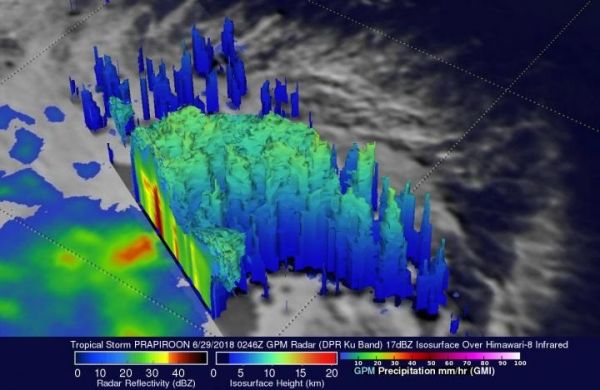When the Global Precipitation Measurement mission or GPM core satellite passed over the Northwestern Pacific Ocean, it saw very heavy rainfall occurring in one part of Tropical Storm Prapiroon.
Tropical Depression 09W was located east of the Philippines when it was upgraded early today, June 29, to Tropical Storm Prapiroon. The tropical storm is in a favorable environment for intensification. Vertical wind shear is low above the tropical cyclone and sea surface temperatures are warm below.
NASA's GPM core observatory satellite had a good view of Tropical Storm Prapiroon on June 29, 2018 at 0246 UTC (June 28 at 10:46 p.m. EDT). GPM is a joint mission between NASA and the Japan Aerospace Exploration Agency, JAXA.
At the time GPM passed overhead, Prapiroon was barely a tropical storm with maximum sustained wind speeds estimated at about 35 knots (40.3 mph). GPM's Microwave Imager (GMI) and Dual-Frequency Precipitation Radar (DPR) instruments measured precipitation around Prapiroon. GPM showed that intensifying the storm was fairly large with its most intense rainfall located in the southern part of the storm. GPM's radar (DPR Ku Band) scanned convective storms in a feeder band on the southwestern side of the tropical storm where it found that some very intense storms there were dropping rain at a rate of over 192 mm (7.6 inches) per hour.
Read more at NASA/Goddard Space Flight Center
Image: NASA's GPM core observatory satellite had a good view of Tropical Storm Prapiroon on June 29, 2018 at 0246 UTC (June 28 at 10:46 p.m. EDT). The storm is fairly large with its most intense rainfall located in the southern part of the storm. Very intense storms on its southwestern side were dropping rain at a rate of over 192 mm (7.6 inches) per hour. (Credit: NASA/JAXA, Hal Pierce)


